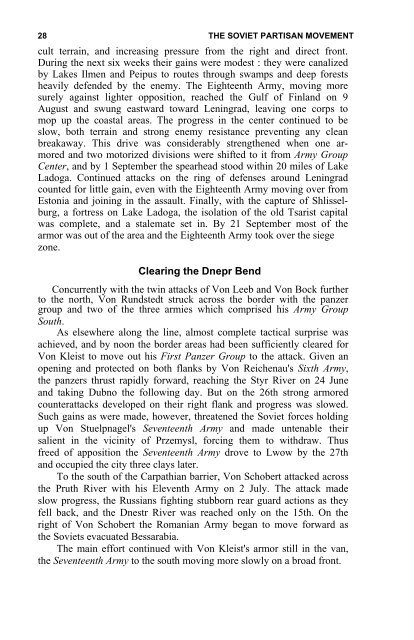the soviet partisan movement 1941-1944 by edgar m. howell
the soviet partisan movement 1941-1944 by edgar m. howell
the soviet partisan movement 1941-1944 by edgar m. howell
Create successful ePaper yourself
Turn your PDF publications into a flip-book with our unique Google optimized e-Paper software.
28 THE SOVIET PARTISAN MOVEMENT<br />
cult terrain, and increasing pressure from <strong>the</strong> right and direct front.<br />
During <strong>the</strong> next six weeks <strong>the</strong>ir gains were modest : <strong>the</strong>y were canalized<br />
<strong>by</strong> Lakes Ilmen and Peipus to routes through swamps and deep forests<br />
heavily defended <strong>by</strong> <strong>the</strong> enemy. The Eighteenth Army, moving more<br />
surely against lighter opposition, reached <strong>the</strong> Gulf of Finland on 9<br />
August and swung eastward toward Leningrad, leaving one corps to<br />
mop up <strong>the</strong> coastal areas. The progress in <strong>the</strong> center continued to be<br />
slow, both terrain and strong enemy resistance preventing any clean<br />
breakaway. This drive was considerably streng<strong>the</strong>ned when one armored<br />
and two motorized divisions were shifted to it from Army Group<br />
Center, and <strong>by</strong> 1 September <strong>the</strong> spearhead stood within 20 miles of Lake<br />
Ladoga. Continued attacks on <strong>the</strong> ring of defenses around Leningrad<br />
counted for little gain, even with <strong>the</strong> Eighteenth Army moving over from<br />
Estonia and joining in <strong>the</strong> assault. Finally, with <strong>the</strong> capture of Shlisselburg,<br />
a fortress on Lake Ladoga, <strong>the</strong> isolation of <strong>the</strong> old Tsarist capital<br />
was complete, and a stalemate set in. By 21 September most of <strong>the</strong><br />
armor was out of <strong>the</strong> area and <strong>the</strong> Eighteenth Army took over <strong>the</strong> siege<br />
zone.<br />
Clearing <strong>the</strong> Dnepr Bend<br />
Concurrently with <strong>the</strong> twin attacks of Von Leeb and Von Bock fur<strong>the</strong>r<br />
to <strong>the</strong> north, Von Rundstedt struck across <strong>the</strong> border with <strong>the</strong> panzer<br />
group and two of <strong>the</strong> three armies which comprised his Army Group<br />
South.<br />
As elsewhere along <strong>the</strong> line, almost complete tactical surprise was<br />
achieved, and <strong>by</strong> noon <strong>the</strong> border areas had been sufficiently cleared for<br />
Von Kleist to move out his First Panzer Group to <strong>the</strong> attack. Given an<br />
opening and protected on both flanks <strong>by</strong> Von Reichenau's Sixth Army,<br />
<strong>the</strong> panzers thrust rapidly forward, reaching <strong>the</strong> Styr River on 24 June<br />
and taking Dubno <strong>the</strong> following day. But on <strong>the</strong> 26th strong armored<br />
counterattacks developed on <strong>the</strong>ir right flank and progress was slowed.<br />
Such gains as were made, however, threatened <strong>the</strong> Soviet forces holding<br />
up Von Stuelpnagel's Seventeenth Army and made untenable <strong>the</strong>ir<br />
salient in <strong>the</strong> vicinity of Przemysl, forcing <strong>the</strong>m to withdraw. Thus<br />
freed of apposition <strong>the</strong> Seventeenth Army drove to Lwow <strong>by</strong> <strong>the</strong> 27th<br />
and occupied <strong>the</strong> city three clays later.<br />
To <strong>the</strong> south of <strong>the</strong> Carpathian barrier, Von Schobert attacked across<br />
<strong>the</strong> Pruth River with his Eleventh Army on 2 July. The attack made<br />
slow progress, <strong>the</strong> Russians fighting stubborn rear guard actions as <strong>the</strong>y<br />
fell back, and <strong>the</strong> Dnestr River was reached only on <strong>the</strong> 15th. On <strong>the</strong><br />
right of Von Schobert <strong>the</strong> Romanian Army began to move forward as<br />
<strong>the</strong> Soviets evacuated Bessarabia.<br />
The main effort continued with Von Kleist's armor still in <strong>the</strong> van,<br />
<strong>the</strong> Seventeenth Army to <strong>the</strong> south moving more slowly on a broad front.
















